|
|
|
During
a recent sojourn in the Leelanau Peninsula, we took the
opportunity to join Joel and Sally Goldberg in paying a visit to
Dan and
Lucie Fontaine Matthies, the proprietors of
Chateau Fontaine,
located near Lake Leelanau. We had just enjoyed a bottle of
2005 Chateau
Fontaine Leelanau Woodland White a few nights previous, so while we were
primed for this little excursion, little did we realize that we were in
for an eye opening adventure.
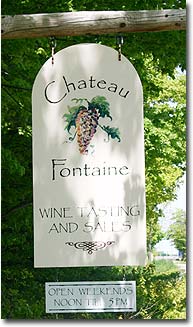 Dan and Lucie bought their property in the mid-70s, and
now farm 27 out of
just under 100 acres. The original vineyard was planted out back from
the tasting room’s present location, on a southern facing slope where
potatoes once grew, at the suggestion of
Stan
Howell, longtime Viticulture / Enology professor at MSU and “the
intellectual godfather of Michigan's modern wine industry,” according to
Joel, who went on to add, “He believed in the ability of northern
Michigan to support wine grape growing when everyone else thought it was
a crazy idea. The only mistake he made was initially to push hybrids,
rather than vinifera. He retired a couple of years ago, and is sorely
missed by many in the industry.” Photo courtesy of
Michwine.com Dan and Lucie bought their property in the mid-70s, and
now farm 27 out of
just under 100 acres. The original vineyard was planted out back from
the tasting room’s present location, on a southern facing slope where
potatoes once grew, at the suggestion of
Stan
Howell, longtime Viticulture / Enology professor at MSU and “the
intellectual godfather of Michigan's modern wine industry,” according to
Joel, who went on to add, “He believed in the ability of northern
Michigan to support wine grape growing when everyone else thought it was
a crazy idea. The only mistake he made was initially to push hybrids,
rather than vinifera. He retired a couple of years ago, and is sorely
missed by many in the industry.” Photo courtesy of
Michwine.com
The Matthies started out as home winemakers, selling most of the grapes
that they didn’t keep for their own use to
Good Harbor Vineyards; their
first commercial vintage was 1997, and they produce a fair range of dry
and semidry whites, two dry reds and a cherry wine that my colleague
Bill Schwab has described as the best in Michigan.
|
Dan was in the ski business when the first vineyard was planted; now,
besides growing grapes and being a winery owner, he is also a vineyard
realtor, and in that capacity, serves in perhaps his most important
role. As he explained to us, “I want it done right. I don’t want
vineyards planted in the wrong places, getting and spreading disease.”
He facilitates a good deal of the land sales intended for vineyard
development in Leelanau County, and told us of one instance in which
he’d been consulted to diagnose the ailment of a vineyard that was
dying. It seems it had been planted in the wrong place, a low-lying
patch of sand. The realtor who sold the property had erroneously told
the buyer that because it was in Leelanau County, he could grow grapes
there, and because the buyer thought the whole notion was romantic and
would be easy to accomplish he was in a hurry to start, it all went
wrong. Dan has a bead on virtually every aspect of the wine industry
there, which is, as we were to discover, on the cusp of a huge boom,
with an ongoing explosion of new plantings, as demand already exceeds
supply. Prime property sells for as much as $10,000-15,000 an acre at
present.
 After exchanging pleasantries with Dan, Lucie and After exchanging pleasantries with Dan, Lucie and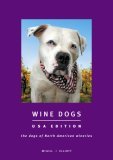 Nick the Winery Dog
(one of the many stars of the book
Wine Dogs), we four visitors piled
into Dan’s four-wheel drive with him and took a wild ride over hill and
dale (much of it off-road, sometimes on precarious inclines), observing
not only Matthies’ extensive plantings, but also those of a number of
his neighbors and colleagues.
Photo of Nick courtesy of
Michwine.com Nick the Winery Dog
(one of the many stars of the book
Wine Dogs), we four visitors piled
into Dan’s four-wheel drive with him and took a wild ride over hill and
dale (much of it off-road, sometimes on precarious inclines), observing
not only Matthies’ extensive plantings, but also those of a number of
his neighbors and colleagues.
Photo of Nick courtesy of
Michwine.com
“I want it done right. I
don’t want vineyards planted in the
wrong places, getting and spreading disease.”
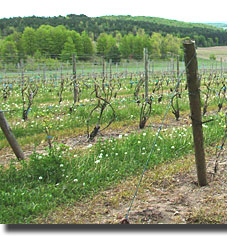 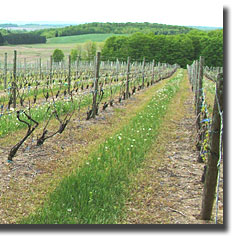
Chateau Fontaine is located on what is known as the French Road Plane,
referring of course to French Road, which takes you right to the tasting
room. This area has some of the highest vineyard property in Michigan,
located 1,000-1,300 feet above sea level. Indeed, we sat upon the crest
of one of Matthies’ vineyards and could look out at both Lake Michigan
to the west and the West Arm of Grand Traverse Bay to the east. To call
the vista impressive is something of an understatement; Kim and I were
amazed to discover that such elevated (and hidden) vineyards existed
anywhere in the state.
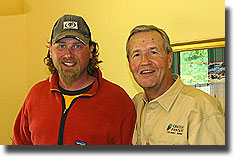 In the course of our tour, we learned that an unnamed Michigan native
associated with the California wine industry has purchased property
bordering the Matthies’, and has 1,600 Chardonnay vines already planted.
Dan facilitated the transaction, and son Doug Matthies
(left, with Dan Matthies), owner of
Big Paw
Vineyard Services, did the planting. As it turns out, Doug’s Big Paw
operation is responsible for putting in about half of the vines in
Leelanau County. Doug himself owns 100 acres on Dufek Road, which will
be planted to Merlot and Auxerrois. Photo courtesy of
Michwine.com In the course of our tour, we learned that an unnamed Michigan native
associated with the California wine industry has purchased property
bordering the Matthies’, and has 1,600 Chardonnay vines already planted.
Dan facilitated the transaction, and son Doug Matthies
(left, with Dan Matthies), owner of
Big Paw
Vineyard Services, did the planting. As it turns out, Doug’s Big Paw
operation is responsible for putting in about half of the vines in
Leelanau County. Doug himself owns 100 acres on Dufek Road, which will
be planted to Merlot and Auxerrois. Photo courtesy of
Michwine.com
“This is big business. This is big capital.
We’re not
competitors here, we’re partners.”
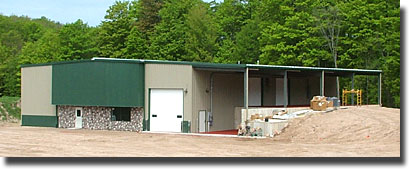 Dan showed us very large vineyard tracts just east of Lake Leelanau that
were planted by Doug for Leelanau Cellars, which has poured hundreds of
thousands of dollars into them. But even they didn’t fully prepare us
for our first sight of the until then under-the-radar, close to fully
built, state-of-the-art winery a little bit further to the east, called
45 North Vineyard & Winery. Once again, the breathtaking terraced vineyard plantings
surrounding the facility are being supervised by Doug Matthies, and
Shawn Walters, one of the most talented young winemakers in Michigan,
was lured away from Leelanau Cellars to assume those duties for the
fledgling operation, owned by Indiana Lasik surgeon Steven Grossnickel.
(Click
here to read more from Joel Goldberg on 45 North.) Dan showed us very large vineyard tracts just east of Lake Leelanau that
were planted by Doug for Leelanau Cellars, which has poured hundreds of
thousands of dollars into them. But even they didn’t fully prepare us
for our first sight of the until then under-the-radar, close to fully
built, state-of-the-art winery a little bit further to the east, called
45 North Vineyard & Winery. Once again, the breathtaking terraced vineyard plantings
surrounding the facility are being supervised by Doug Matthies, and
Shawn Walters, one of the most talented young winemakers in Michigan,
was lured away from Leelanau Cellars to assume those duties for the
fledgling operation, owned by Indiana Lasik surgeon Steven Grossnickel.
(Click
here to read more from Joel Goldberg on 45 North.)
One other property worth mentioning that Matthies took us to was
Isadore’s Choice, with its marvelous vistas and beautiful hillside
vineyards. No expense was spared in the creation of this lovely estate,
and it’s not all window dressing, either. “This is big business,”
Matthies explained, “This is big capital. We’re not competitors here,
we’re partners.” Kim and I have had the opportunity to taste a more than
merely credible Isadore’s Choice Chardonnay, and we’ve heard very good
reports about their Pinot Noir as well. Further investigation is
necessary; we’ll report back with our findings.
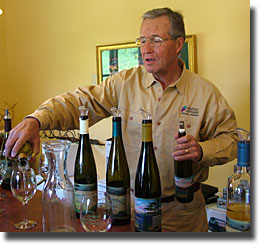 We
returned to the tasting room and Dan, Lucie and Nick sampled us through
all of their current offerings. While there we rubbed elbows with a
reporter and a photographer on assignment for the New York Times
scouting the area for an upcoming piece in the Travel section. We also
had the opportunity to meet Doug Matthies, who just happened to stop by.
Total case production at Chateau Fontaine is a little over 5,000 cases;
almost all of the wines weigh in at around 12% alcohol by volume. We
returned to the tasting room and Dan, Lucie and Nick sampled us through
all of their current offerings. While there we rubbed elbows with a
reporter and a photographer on assignment for the New York Times
scouting the area for an upcoming piece in the Travel section. We also
had the opportunity to meet Doug Matthies, who just happened to stop by.
Total case production at Chateau Fontaine is a little over 5,000 cases;
almost all of the wines weigh in at around 12% alcohol by volume.
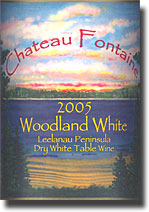 2005 Chateau Fontaine Leelanau Woodland White (Auxerrois), $12:
Pale gold color, slightly oily, with a good deal of glycerin, almost
honeyed, and certainly very ripe (Dan tells us that Auxerrois
gets riper than any other grape he grows) and fairly low in acid.
Flavors and aromas are reminiscent of yellow apple, pear and melon, and
if only it had some minerality, it’d be even more enjoyable, at least
for this taster. As it is, it’s still a pleasant, food friendly glass of
wine that we liked well enough to bring more home. When asked why
Auxerrois isn’t mentioned anywhere on the label, Dan told us frankly,
“Because people wouldn’t buy it.” Tasted three times with consistent
impressions. 2005 Chateau Fontaine Leelanau Woodland White (Auxerrois), $12:
Pale gold color, slightly oily, with a good deal of glycerin, almost
honeyed, and certainly very ripe (Dan tells us that Auxerrois
gets riper than any other grape he grows) and fairly low in acid.
Flavors and aromas are reminiscent of yellow apple, pear and melon, and
if only it had some minerality, it’d be even more enjoyable, at least
for this taster. As it is, it’s still a pleasant, food friendly glass of
wine that we liked well enough to bring more home. When asked why
Auxerrois isn’t mentioned anywhere on the label, Dan told us frankly,
“Because people wouldn’t buy it.” Tasted three times with consistent
impressions.
2005 Chateau Fontaine Leelanau Pinot Gris, $14: Picked at 22-23
Brix, not fermented on the skins; rich medium straw to pale gold color,
with rich, ripe apple and pear shaded with a hint of herbaceousness in
both flavor and aroma. Good acids, smooth texture and nice depth; makes
a great match for whitefish and perch. We liked this well enough to
bring one home, and it gives added evidence that Pinot Gris/Grigio
does
very well indeed in the Traverse area.
2005 Chateau Fontaine Leelanau Chardonnay, $12: Medium straw
color, with good varietal, showing flavors and aromas of rich, round
pear accented with subtle herb, mineral and only moderate oak at most;
good depth, cut and length.
2006 Chateau Fontaine Leelanau Gewurztraminer: This medium straw
had been bottled just four days before we tasted it, and Dan says it
needs time for balance and complexity, and will be at its best in about
6 months (November of ‘07); it has 1.4% residual sugar “to highlight the
fruit.” It offers spicy apple flavors and aromas with a touch of
sweetness right now; I’d like to revisit it around Christmas to see how
it’s developed.
2005 Chateau Fontaine Leelanau White Riesling, $14: Pale to
medium straw color, with ripe pear, peach and apricot flavors and aromas
accented with some subtle pine and a hint of sweetness. Medium bodied,
with good acids and length.
2005 Chateau Fontaine Leelanau Pinot Noir, $16: Matthies says
that this vintage is “the best that we have done” with this varietal,
citing Robert Sinsky as the model and the influence; it saw eight months
in French oak. Ruby garnet color, with black cherry character shaded
with a hint of earth underneath; medium bodied and pleasant, showing
good possibilities for both this and future vintages, but not quite
there yet.
2005 Chateau Fontaine Leelanau Woodland Red, 80% Cabernet Franc, 12%
Merlot, 8% Syrah, $20: Only the 2nd vintage of this wine produced;
2004 was the first; 350 cases produced. Dark garnet color, with big
cherry flavors and aromas underscored with a note of earth and a little
animal fur. Fruity and easy to drink; soft and ready,
although Dan says it’s still coming on.
Chateau Fontaine Leelanau Cherry Wine, $8: Dark cherry red color,
blending three different cherries; Dan Matthies claims it tastes like
“cherry pie in a bottle,” and damned if it doesn’t, being a little tart
and a little sweet at the same time. It has a certain perfumed quality
to it, and Kim mentions a note of pepper; it makes a nice match with a
kiss of Hershey’s Dark Chocolate.
A visit to Chateau Fontaine is definitely worthwhile if you find
yourself in the Leelanau Peninsula; the wines range from good to very
good, and you won’t find a more passionate ambassador for the
appellation than Dan Matthies. You’ll also get the chance to take a
gander at one of the coolest restroom walls (almost completely covered
with wine corks from around the world) to be found anywhere in any wine
country.
Reporting from Day-twah,
Bastardo

Other Recent Wine Explorations
Red Wings and Red
Rhônes Playoff Diary-Round Three
A Bunch O' Whites
(& One Pinky)
Left Foot Charley
Red Wings & Red Rhônes
Playoff Diary - Round Two
Better Red Than Dead
Red Wings & Red Rhônes
Playoff Diary - Round One
Back to the
July 2007 Index
Back to the Underground
Index
Back to the Top


© George Heritier July, 2007
|
 After exchanging pleasantries with Dan, Lucie and
After exchanging pleasantries with Dan, Lucie and Nick the Winery Dog
(one of the many stars of the book
Wine Dogs), we four visitors piled
into Dan’s four-wheel drive with him and took a wild ride over hill and
dale (much of it off-road, sometimes on precarious inclines), observing
not only Matthies’ extensive plantings, but also those of a number of
his neighbors and colleagues.
Photo of Nick courtesy of
Michwine.com
Nick the Winery Dog
(one of the many stars of the book
Wine Dogs), we four visitors piled
into Dan’s four-wheel drive with him and took a wild ride over hill and
dale (much of it off-road, sometimes on precarious inclines), observing
not only Matthies’ extensive plantings, but also those of a number of
his neighbors and colleagues.
Photo of Nick courtesy of
Michwine.com


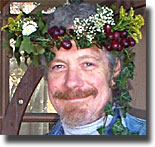
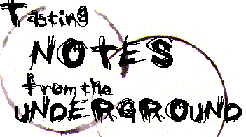

 Dan and Lucie bought their property in the mid-70s, and
now farm 27 out of
just under 100 acres. The original vineyard was planted out back from
the tasting room’s present location, on a southern facing slope where
potatoes once grew, at the suggestion of
Dan and Lucie bought their property in the mid-70s, and
now farm 27 out of
just under 100 acres. The original vineyard was planted out back from
the tasting room’s present location, on a southern facing slope where
potatoes once grew, at the suggestion of


 In the course of our tour, we learned that an unnamed Michigan native
associated with the California wine industry has purchased property
bordering the Matthies’, and has 1,600 Chardonnay vines already planted.
Dan facilitated the transaction, and son Doug Matthies
(left, with Dan Matthies), owner of
Big Paw
Vineyard Services, did the planting. As it turns out, Doug’s Big Paw
operation is responsible for putting in about half of the vines in
Leelanau County. Doug himself owns 100 acres on Dufek Road, which will
be planted to Merlot and Auxerrois. Photo courtesy of
In the course of our tour, we learned that an unnamed Michigan native
associated with the California wine industry has purchased property
bordering the Matthies’, and has 1,600 Chardonnay vines already planted.
Dan facilitated the transaction, and son Doug Matthies
(left, with Dan Matthies), owner of
Big Paw
Vineyard Services, did the planting. As it turns out, Doug’s Big Paw
operation is responsible for putting in about half of the vines in
Leelanau County. Doug himself owns 100 acres on Dufek Road, which will
be planted to Merlot and Auxerrois. Photo courtesy of
 Dan showed us very large vineyard tracts just east of Lake Leelanau that
were planted by Doug for Leelanau Cellars, which has poured hundreds of
thousands of dollars into them. But even they didn’t fully prepare us
for our first sight of the until then under-the-radar, close to fully
built, state-of-the-art winery a little bit further to the east, called
Dan showed us very large vineyard tracts just east of Lake Leelanau that
were planted by Doug for Leelanau Cellars, which has poured hundreds of
thousands of dollars into them. But even they didn’t fully prepare us
for our first sight of the until then under-the-radar, close to fully
built, state-of-the-art winery a little bit further to the east, called
 We
returned to the tasting room and Dan, Lucie and Nick sampled us through
all of their current offerings. While there we rubbed elbows with a
reporter and a photographer on assignment for the New York Times
scouting the area for an upcoming piece in the Travel section. We also
had the opportunity to meet Doug Matthies, who just happened to stop by.
Total case production at Chateau Fontaine is a little over 5,000 cases;
almost all of the wines weigh in at around 12% alcohol by volume.
We
returned to the tasting room and Dan, Lucie and Nick sampled us through
all of their current offerings. While there we rubbed elbows with a
reporter and a photographer on assignment for the New York Times
scouting the area for an upcoming piece in the Travel section. We also
had the opportunity to meet Doug Matthies, who just happened to stop by.
Total case production at Chateau Fontaine is a little over 5,000 cases;
almost all of the wines weigh in at around 12% alcohol by volume.